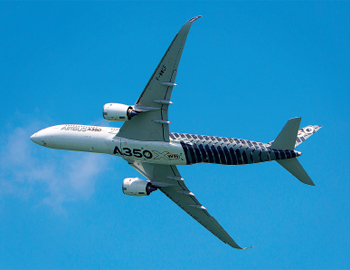- Prime Minister Narendra Modi inaugurates Aero India 2023 in Bengaluru; Releases Commemorative Stamp
- Defence Secretary meets delegations from Saudi Arabia, USA and Oman on the sidelines of Aero India 2023
- Foreign Ministers of 32 countries to attend Aero India 2023
- Embraer showcases the C-390 Millennium at Aero India 2023
Airbus will deliver one aircraft per week over the next 10 years

That India is a hugely important market for airframers is a given fact. Airbus has been in India for much longer than one can remember and its relationship with India has been growing from strength to strength, from a seller to a partner, the journey has been long. Giving further details of Airbus’ interest in India, the Head of Airline Marketing (South Asia), Airbus, Aymeric Dupront, in an exclusive interview with the Editor-in-Chief of SP’s ShowNews Jayant Baranwal, has pointed out how every Airbus aircraft has something to do with India. Excerpts:
SP’s ShowNews (SP’s): Airbus recently made the first delivery of A350 XWB (extra wide body) to Singapore Airlines. What is so special about it?
Airbus: The Airbus A350 XWB is a game-changer. It has 25 per cent lower fuel consumption, nextgeneration aircraft with great versatility of regional and ultra-long range capabilities. It is a key product for Singapore Airlines giving it option of using it regionally or on long range. Singapore Airlines is one of the largest A350 900 customers and it is the second Asian operator of the aircraft. It is the first of the four new Asian customers who will get the aircraft this year. The aircraft will further increase positioning of Singapore Airlines with regard to long haul flights. It has an ultra-long range capability for flights of up to 19 hours from Singapore to J.F.K. airport in New York. The A350 XWB will be very useful for all the Indian operators who can fly to any destination in Europe. It offers airlines low cost of operation, high profitability and direct long haul routes between India and the US.
SP’s: What you are saying is it will be a nice aircraft for the Indian operators... whether it is Air India, IndiGo, AirAsia, Vistara. Are you talking to all these airlines?
 Airbus: Of course, whatever the market, this aircraft can serve it. It is a game-changer. We are talking to all our customers about our products and for the long haul market, the A350 XWB can play a strong role for operators. In fact, this morning the aircraft had its first revenue flight for Singapore Airlines.
Airbus: Of course, whatever the market, this aircraft can serve it. It is a game-changer. We are talking to all our customers about our products and for the long haul market, the A350 XWB can play a strong role for operators. In fact, this morning the aircraft had its first revenue flight for Singapore Airlines.
SP’s: How do you see the airlines industry in India moving under the new government regime – stagnant/growing/reversing – and why?
Airbus: First of all, the airline industry in India is definitely growing. Over the last few months the domestic growth has been 20 per cent and this trend will continue. Why this trend will continue is because all the fundamentals are strong… you have a strong middle class; very high GDP growth and corresponding consumption; low number of aircraft in India today, there are less than 400 jets, one of the lowest in the world for India’s size. We have a vision for Indian growth and we will give the details of the vision at the India Aviation event in Hyderabad.
SP’s: Do you believe that the airlines potential in India is still untapped?
Airbus: Actually when you look at figures today, in India an Indian is doing on an average one air trip every 14 years which is low; a Chinese is doing one air trip every three years and in Europe and the US it is less than one trip every year. I agree there is a large potential in India which is waiting to be tapped. Right now, less than 4 per cent of domestic travellers are doing trips by air. So, definitely as the economy expands, so will the aircraft movements.
SP’s: Would you like to comment on 5/20 rule of India? Do you agree that this rule is disruptive in the growth of India’s civil aviation?
Airbus: Basically we trust the operators with their decision. I don’t want to comment on this. But we will support the operators on whatever decision they take.
SP’s: Recently, we had an exclusive interview with the Civil Aviation Minister and he personally believes that the rule has to go.
Airbus: Whatever the decision of the Minister takes, we will honour the decision.
SP’s: Does Airbus perceive competition from the railways as this remains the strongest and most popular means to travel within the country irrespective of the price levels?
Airbus: First of all that railways remains strong and popular is good news. There is still small option of domestic trips which happen by air. Air transport is limited and this demonstrates that all of India will benefit by proper transportation network. A strong railways is a partner and not a competitor. The railways can also feed the airlines which operate on international routes.
SP’s: What kind of percentage of railway traveller can one expect to reach in 10 years as air traveller?
Airbus: This is very difficult question to answer. We cannot compare India with any other country too as India is a subcontinent and the distances within are huge. It will be difficult to estimate what will be the share of air transport to rail transport. Definitely it will grow, but it is difficult to point out.
SP’s: Smaller airports—Tier-II and -III level cities – what do you think is the solution in terms of proper connectivities and serve such destinations through the eyes of Airbus?
Airbus: There is growth that is agreed upon. You are right to point out that growth is not only from metro to metro or Tier-I to city but growth is also from smaller sectors and Tier-III level cities. On Tier-II cities, the airlines can operate jets such as A320 to reach the markets efficiently. It is true that in the new markets connecting Tier-II or Tier-III level cities, one might need an aircraft which offers seats less than what an A320 or 737 can offer. In India our view is that due to high octane prices in some states and relatively low revenues, destinations with less than 100 seats can be definitely served by turboprop aircraft. In India it is very difficult for jets below 100 seats to be profitable. In our view for the future of India, metro to metro traffic jets with 150 seats and traffic from smaller cities the turboprops would be the most ideal way to tap the growth in the country.
SP’s: There is an ongoing debate – overcapacity versus right capacity. What are your views on this?
Airbus: This is one of the solutions of Indian airlines to tap the growth, as long as the smaller aircraft is turboprops it is good. Jets with less than 100 seats will not be profitable.
SP’s: Jets will not be a good option according to you for regional connectivity?
Airbus: Depending on the sector and markets, but certainly turboprops are strong alternatives than jets.
SP’s: But turboprops take long to reach destinations.
Airbus: Yes, in the case of India right now turboprops are ideal. India is a high growth market, served well by A320 or 737. A very small aircraft will become smaller in the next few years and will be served by the bigger jets. So it makes perfect transition.
SP’s: What kind of future do you foresee in the context of airline operations with the fuel prices which are currently down but might go up?
Airbus: The volatility of the fuel prices is something one cannot predict. Especially in India where fuel accounts for substantial cost of operations, there is need to unlock profitability for which airlines will have to look at long-term solutions. When fuel prices go up, airlines may not have a choice, so it is essential to find an aircraft which has lower fuel burn and which can accommodate more seats on the aircraft and that is what Airbus is offering with its single aisle aircraft.
SP’s: How would you comment on price war that is taking place in India? Is this a healthy and sustainable practice?
Airbus: India is a competitive market and it will be difficult to unlock profitability particularly when the competition is strong. The only way to deal with such a situation is for the aircraft to be an enabler. The single aisle A321 can fit up to 240 seats and these provide airlines capacities from which they can earn.
SP’s: What kind of positioning Airbus expects in India in view of the market dynamics evolving quite fast?
Airbus: Airbus has above 70 per cent market share. It has aircraft with low fuel burn. The A320neo is a game-changer. We have 530 aircraft to be delivered to India, that is one delivery every week over the next 10 years. We have more single aisle aircraft, 246 A320neo and it has a strong role to play in the next few years.
SP’s: How do you perceive the potential of A380 sales in India?
Airbus: The A380 is a transport leader and its sales is increasing. It helps in solving congestion of passengers. A380 is one solution for long haul markets and has a good demand for destinations from India to long distances. It can unlock new direct markets and a number of carriers have recognised this strength. It can fly efficiently from Mumbai to Singapore and even further.
SP’s: Could you give details about your future innovation, particularly when we hear media reports that a new development that may happen in aviation is an aircraft flying from London to Sydney in 11 minutes which is next to impossible. What is Airbus working on?
Airbus: We are working on different projects. Our next projects are for shortterm. This year we are working on A350 100; which is a big step for us. The A350 XWB long range is another big improvement. The A321neo has improved low fuel consumption. These are many development needs of the industry and we are addressing them.
SP’s: Airbus has been sourcing material from India and it has touched $500 million. Will you be sourcing more from India?
Airbus: Yes, we are sourcing substantially from India and different parts of the world. For instance, a lot of aviation equipment supplies such as engines come from the UK, the US and other places. India is also important sourcing hub. Nothing is decided on how we expand this but surely it is going to happen.
It just shows our commitment to India is long-term. India is hugely a most important market for Airbus. There is an untapped potential which is huge. It is going to be among the top five economies in the world and the requirement of aircraft would go up. Indians wanting to travel within the country is going up, it is good growth anywhere in the world. We are extremely proud of our presence in India and Airbus has a bit of India in each and every aircraft.





